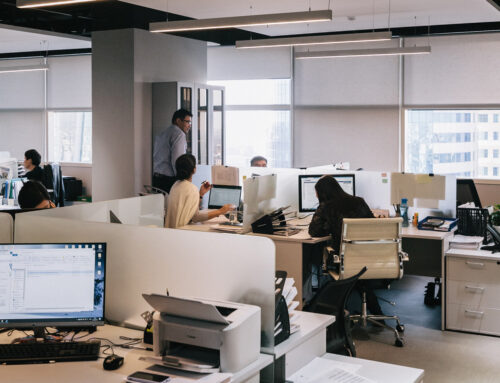Hot desking is a flexible working concept that allows employees to work from any available desk in a communal workspace, rather than assigning them to a fixed workstation. This practice has been growing in popularity as more companies adopt hybrid or remote work models, as well as in response to the need for cost-effective and space-efficient office solutions. Office Clearance London will discuss its purpose, benefits, drawbacks and more.
The concept of hot desking
The concept of hot desking is a flexible approach to office space utilisation that allows employees to work from any available desk or workspace within a shared environment. This means that employees do not have a designated workspace and can move around the office as needed.
Origins and history
The concept of hot desking is not new. It was first introduced in the 1990s by Silicon Valley tech companies looking for ways to optimise office space and encourage cross-functional collaboration. However, it was not until the early 2000s that the practice gained momentum as companies worldwide began to recognise its potential benefits.
The origins of hot desking can be traced back to the rise of the gig economy, where freelancers and independent contractors often work from shared workspaces. The idea behind hot desking is to create a similar environment within a traditional office setting, where employees can work flexibly and collaboratively.
Benefits of hot desking
Hot desking offers a range of benefits to both employees and employers. It promotes flexibility, collaboration, and a sense of community by breaking down traditional hierarchical office structures and encouraging cross-team communication. It also helps businesses reduce overhead costs, optimise office space utilisation, and make significant savings on real estate expenses.
Furthermore, hot desking encourages productivity, as employees are not restricted to their usual location and can change their desks depending on their current needs. It also allows businesses to be more agile, as teams can be reorganised and reshuffled quickly and efficiently.
Another advantage of hot desking is that it can help to reduce the environmental impact of an office. By sharing resources such as printers and other office equipment, businesses can reduce their carbon footprint and contribute to a more sustainable future.
Drawbacks and challenges
Despite its many advantages, hot desking is not without its challenges. Firstly, employees may struggle to adjust to the concept of not having a designated workspace, which may lead to a loss of control, independence, and privacy.
In addition, hot desking can make it challenging to build relationships and foster collaboration, as team members are often physically separated from one another. Furthermore, it may lead to heightened noise levels, which can be disruptive to some employees and may impact productivity levels.
Another challenge of hot desking is that it requires a significant amount of planning and organization. Businesses need to ensure that there are enough desks and workspaces available for all employees, and that the office layout is conducive to collaboration and productivity.
Finally, hot desking may not be suitable for all types of businesses or employees. Some people may prefer the structure and routine of a designated workspace, while others may require a high level of privacy or security.
In conclusion, hot desking is a flexible and innovative approach to office space utilisation that offers a range of benefits to both employees and employers. However, it is not without its challenges, and businesses need to carefully consider whether it is the right approach for their organisation.
Implementing hot desking in the workplace

what is hot desking 2
Choosing the right office layout
The key to successfully implementing hot desking in the workplace is to choose the right office layout and design. This includes having a variety of different workspaces that cater to different needs and preferences, such as private areas for phone calls or quiet work, shared spaces for collaboration, and social areas for informal meetings and breaks.
Establishing a hot desking policy
Before implementing hot desking, it is essential to establish clear guidelines and policies. This includes establishing a system for scheduling desks, setting rules on desk cleanliness, and encouraging employees to respect the workspace of others. It is also essential to ensure that there are enough desks available for employees to avoid overcrowding.
Managing reservations and scheduling
One of the most critical aspects of hot desking is effective scheduling and desk reservation systems. These may include digital tools or software that allow employees to book desks in advance, as well as physical indicators such as desk tags or reservation signs.
Ensuring cleanliness and hygiene
Hot desking can increase hygiene risks since different people use the same workspace. To mitigate this risk, companies must provide adequate cleaning supplies, including antibacterial sprays and wipes. Additionally, employees should be encouraged to wipe down their desks and shared equipment before and after use.
Hot desking and remote work

what is hot desking 4
Hot desking and remote work have become increasingly popular options for companies looking to adapt to a hybrid work model. With the ongoing pandemic, many employees have become accustomed to working from home, and the idea of returning to a traditional office setup can be daunting. However, hot desking provides a flexible office setup that can make the transition back to the office easier for employees.
Adapting to a hybrid work model
Hybrid work models allow employees to split their time between working from home and the office. This approach has many benefits, including increased flexibility and improved work-life balance. However, it also requires a different approach to office setup and management. Hot desking can help to create a more flexible and adaptable office environment that can accommodate the needs of employees who are working remotely, as well as those who are working in the office.
Balancing flexibility and collaboration
One of the biggest challenges of hybrid work models is finding the right balance between flexibility and collaboration. While remote work can provide employees with more autonomy and flexibility, it can also lead to feelings of isolation and disconnection. Hot desking can help to address this issue by creating a diverse range of workspaces that cater to different types of work and preferences. This can include quiet spaces for focused work, collaborative areas for team projects, and social spaces for casual interactions.
Tools and technology for seamless hot desking
Advances in software and technology have made it easier to implement and manage hot desking. These tools can include booking systems that allow employees to reserve desks and workspaces in advance, desk sensors that track occupancy and usage, and collaborative software that promotes communication and project management. By using these tools, companies can create a seamless and efficient hot desking experience that benefits both employees and the organisation as a whole.
Overall, hot desking and remote work are powerful tools for companies looking to adapt to a hybrid work model. By providing a flexible office setup and leveraging the latest technology, companies can create a more adaptable and productive workplace that meets the needs of all employees.
Success stories and case studies
Hot desking has become a popular trend in the modern workplace, and has been successfully implemented by a range of companies, including large corporations, startups, and non-profit organisations. One such example is PwC, which uses hot desking across its offices to promote flexibility and collaboration. By adopting this approach, PwC has been able to create a more dynamic and agile work environment, allowing employees to work together more effectively and efficiently.
Another successful example is Airbnb, which has adopted a hybrid model that relies on hot desking to support remote work. By providing employees with the flexibility to work from anywhere, Airbnb has been able to attract top talent from all over the world, and create a truly global workforce.
Lessons learned from successful implementations
Successful hot desking implementations have several common traits. One of the most important is effective communication. Companies must communicate clearly and regularly with employees throughout the process, explaining the benefits of hot desking and addressing any concerns or questions that may arise. Additionally, clear policies must be put in place to ensure that the system is used effectively and efficiently.
Another key factor is a well-planned office layout that caters to employee needs. This includes providing a variety of workspaces, such as private offices, collaborative areas, and quiet zones, as well as ensuring that employees have access to the tools and resources they need to do their work effectively.
Finally, employee feedback and engagement in the process are essential for ensuring a successful transition. Companies must involve employees in the planning and implementation of hot desking, and seek their input and feedback throughout the process. By doing so, companies can ensure that the system is tailored to the specific needs and preferences of their employees.
Overcoming common obstacles
While hot desking can be a highly effective way to improve collaboration and flexibility in the workplace, it can also be challenging to implement. Common obstacles include resistance from employees, a lack of infrastructure, and a failure to adequately communicate the benefits of the system.
To overcome these obstacles, companies must take a proactive approach to addressing concerns and seeking employee feedback throughout the process. This may involve providing training and support to help employees adjust to the new system, as well as regularly communicating the benefits of hot desking and how it can help them work more effectively and efficiently.
Ultimately, the success of hot desking depends on a variety of factors, including effective communication, clear policies, and a well-planned office layout. By taking a proactive approach to implementation, and seeking employee feedback and engagement throughout the process, companies can create a more dynamic and agile work environment that benefits both employees and the organisation as a whole.
Conclusion
In conclusion, hot desking is a flexible and cost-effective office solution that can promote collaboration, agility, and productivity. Successful implementation requires careful planning, clear policies, and effective communication with employees. Companies that embrace hot desking can benefit from increased space utilisation, improved employee engagement, and enhanced flexibility. However, it is crucial to prioritise cleanliness and hygiene and be aware of the potential challenges and drawbacks of the system.




